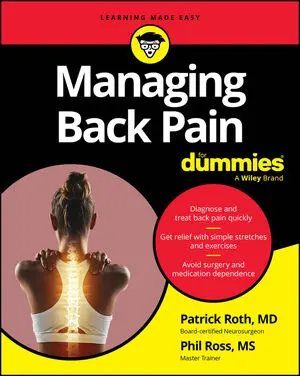Your back hurts, and you want to know what to do about it. Congratulations! You’ve come to the right place. We may not be able to tell you what’s causing your pain (probably nobody can), but we can tell you how to build a stronger back, and that’s likely to make the pain go away or reduce it to a point at which you can start enjoying your life again.
This handy Cheat Sheet is a quick reference for back pain management basics. It helps you decide when to see a doctor for your back pain, gives you some good reasons to avoid doctors and diagnoses, presents a common-sense approach to diagnosis, introduces you to your hidden core (back muscles), presents a quick reference to six broomstick exercises for limbering up your back, provides a list of healthcare professionals who can jump-start or accelerate your own efforts to build a stronger back, and presents ten tips for building and maintaining a strong, resilient back.
How to know when to see a doctor for your back pain
Most people with back pain are wise to steer clear of doctors and try their best to manage their back pain on their own. However, sometimes, medical intervention may be the most prudent option. To determine whether you’d be wise to see a doctor, look for the following red flags:
- Back pain lasting longer than six weeks: Pain that isn’t resolving on its own is more likely to be related to an underlying physical cause that may need medical attention.
- Age under 18 or over 50 years: Typical low back pain is unusual in children and may reflect a more serious origin. New back pain in the elderly is often associated with osteoporotic fractures, spinal stenosis, and arthritis.
- History of cancer: If you or other family members have had cancer, you want to consider it as a possible source of back pain. An onset of cancer may manifest itself in the form of back or neck pain. Patients suffering from esophageal cancer often experience neck pain well prior to the diagnosis of cancer.
- History of weight loss: Weight loss may indicate a nutritional deficiency or other underlying medical condition that could be causing or contributing to your back pain. If a person loses weight too rapidly or with the aid of prescription weight loss drugs, they may suffer a reduction of muscle tissue, thus lessening the support of the spine, which can result in back pain.
- History of fever: A history of fever may be a sign of underlying infection, which could affect the spine, nerves, or supporting tissues. The fever may be indicative of an infection. For example, an infection of the kidneys will result in a fever and back pain.
- History of physical trauma: If you’ve had a serious fall or an accident (car, motorcycle, bicycle, sports injury, or something similar), your spine or its supporting structures may have been damaged and failed to heal properly. The weakened muscles and misalignment of the structure would result in pain and discomfort while moving. A compensatory gait due to loss of motion, strength, and misalignment may result in back pain as well.
- Arm or leg weakness: Muscle weakness may be an indication of nerve damage or pressure on a nerve. If the pathways of the nerves are impinged, the signal will not reach the extremities, possibly resulting in lost or impaired function.
- Bowel of bladder dysfunction: Bowel or bladder dysfunction may indicate an issue affecting the nerves or an underlying condition, such as kidney stones or urinary infection, which can cause back pain. Pinched nerves, spinal cord injury, herniated and bulging discs, as well as spinal stenosis, can lead to bowel and bladder control issues as well.
Think twice about demanding a diagnosis for your back pain
Doctors and patients alike often become so obsessed with figuring out what’s causing the pain that it clouds their judgment. Jumping to conclusions can lead to expensive and unnecessary treatment that can do more harm than good.
The take-home message here is not to be too hasty to consult a doctor or too demanding to have your doctor diagnose what’s causing your back pain. A diagnosis can be helpful if your back pain is related to a clear physical cause that can be confirmed as the source of your back pain, but more likely than not, either 1) your doctor can’t be certain what’s causing the pain, or 2) the cause doesn’t matter — the solution (strengthening your back) will work just as well whether you know the source of the pain or not.
Find the pain generator or give up the search
If you or your doctor has good reason to suspect that your back pain is due to injury or the pain has been significantly diminishing your quality of life, we believe that the best approach is to perform an all-out search for the pain generator. If that fails to identify and confirm a clear cause of the pain, abandon the search altogether. Here’s the step-by-step approach we recommend:
- Conduct a deep dive to identify the pain generator. Perform a comprehensive physical evaluation, examine the patient’s medical and family history, order targeted lab tests, and order medical imaging, including a magnetic resonance image (MRI), plain X-rays done in flexion (spine bent forward) and extension (spine bent backward), and a single-photon emission computed tomography (SPECT) scan. Occasionally, imaging of the abdomen, shoulder, hip, and other areas is added to look for non-spinal origins of the pain.
- If the deep dive reveals a definitive pain generator, provide treatments that target it. Treatments should be limited to those that are predictably helpful, such as treatment for an isolated spondylolisthesis (a vertebra slipped out of place), a spinal instability, a large herniated disc, or an infection.
- If the deep dive fails to reveal a definitive pain generator, abandon the search and shift gears to treat the pain and the patient. Note that effective treatment for back pain is still possible, even in the absence of a clear pain generator. Doctors can still treat the pain and help restore patient health and fitness, which can do wonders for alleviating back pain.
This approach gets a lot of pushback from insurance providers who believe the search for a pain generator is costly and doesn’t amount to better results. We disagree. The reason the search for the pain generator has traditionally been expensive is that providers often misuse whatever they find on a patient’s MRI to justify unnecessary, expensive, and ineffective treatments. However, if the search for the pain generator is used instead to either identify the pain generator or to rule it out, subsequent treatment can be both more affordable and more effective.
Master hidden core fundamentals
When most people exercise to strengthen their core, they focus on the muscles they can see when they look in a mirror — the “six-pack” abdominals, the obliques, and the pectorals — and they ignore their back sides. Well, some people do work on their booties, but their backs remain neglected. The hidden core comprises these neglected muscles, especially the ones that run along the spine and support it directly.
In Managing Back Pain For Dummies, we provide dozens of exercises for strengthening your hidden core. In preparation for those exercises, master these hidden core fundamentals:
- Maintain a neutral spine all the time. By “neutral spine,” we’re referring to a spine in its most stable position, with a gentle curve backward (lordotic) at the neck (cervical spine) and at the lower (lumbar) spine. Whether you’re standing, sitting, lying down, squatting down to pick something up, or doing anything at all, keep your spine in the neutral position.
- Pack your shoulders. Pull your shoulders back (bring your shoulder blades closer together) and slightly down. Packing your shoulders helps you maintain a neutral spine.
- Tighten your butt and gut. Tensing your abs and glutes creates a solid foundation for supporting your spine and transferring weight down through your hips to your legs.
- Master the hip-hinge. Don’t curve your spine when you bend over to touch your toes, pick something up, or lift something. Remember: Maintain a neutral spine all the time. If you need to reach down, squat and hip-hinge, as shown in the figure below.
- Breathe behind the shield. “Breathing behind the shield” involves maintaining tension in the core and compression in the lungs to brace the spine, especially when picking up an object or hoisting it overhead. What you’re doing is filling your lungs with air while tensing your core muscles to create a solid air-filled structure — a pneumatic pillar of support. This structure carries much of the load that would otherwise be transferred to your spine.
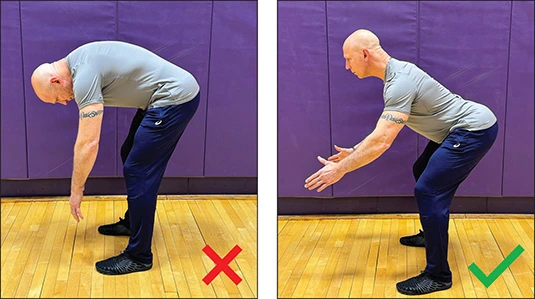
Mobilizing your back: Six essential broomstick exercises
Broomstick exercises are great for limbering up your back and improving your posture. You can perform these exercises using a broomstick or any narrow rod that’s about as long as you are tall (or a couple of inches shorter). If you’re into martial arts, consider using a bo staff.
Perform these six broomstick exercises at least once in the morning and several times over the course of the day if possible. (Do at least ten reps of each exercise.)
- The neutral spine drill: Hold your staff behind you vertically along your spine so it touches the back of your skull, your upper back, and the point where your lower back meets your butt, and then hip-hinge so that your spine remains in contact with the three aforementioned points.
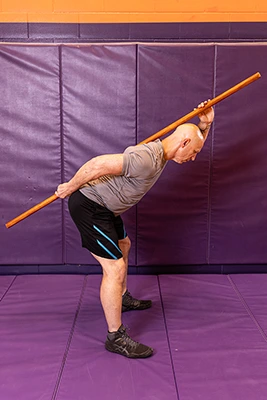
- Side twists: Hold the staff across your shoulders, tighten your butt and gut, and twist your torso slowly from side to side as far as comfortably possible.

- Side bends: Hold the staff across your shoulders, tighten your butt and gut, and bend slowly from side to side as far as comfortably possible.
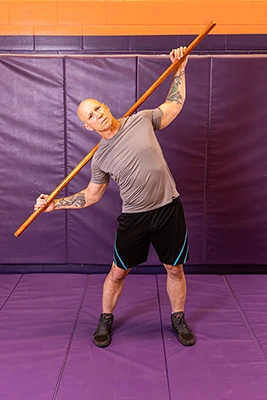
- Reach backs: Hold the staff across your shoulders, tighten your butt and gut, pull your elbows back by bringing your shoulder blades closer together, and then relax to return your elbows to their starting position. Imagine “flapping” your wings while maintaining your grip on your staff.
- Bent over twists: Hold the staff across your shoulders, tighten your butt and gut, hip-hinge so that your torso is at about a 45-degree angle to the ground, and twist your upper body clockwise and counterclockwise slowly as far as comfortably possible.
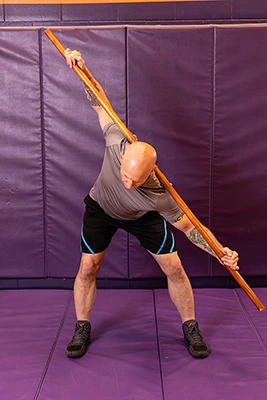
- Good mornings: Hold the staff across your shoulders, tighten your butt and gut, and hip-hinge forward as far as comfortably possible without bending your knees. Good mornings are a great way to stretch your hamstring muscles.
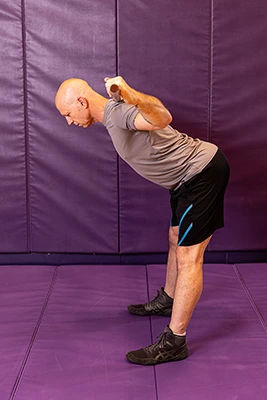
Professionals who can help you manage your back pain
Our approach to managing back pain is designed to build self-efficacy — the belief that you can do what’s necessary to manage your back pain. However, self-efficacy isn’t necessarily self-reliance. Several types of healthcare professionals can help you jump-start or accelerate your self-care regimen, including the following:
- Primary care physician (or internist): A primary care physician who has a sophisticated understanding of back pain and the broad array of treatment options can be a tremendous resource for treating acute pain and referring you to the right specialist(s).
- Functional/integrative practitioner: Practitioners of functional and integrative medicine tend to spend more time with their patients and focus on the building blocks of health (an approach we strongly favor) rather than medicines or surgery.
- Physical therapist: A skilled physical therapist provides a personalized treatment plan that often includes exercise, deep-tissue massage, postural training, and temporary pain relief, all for the purpose of restoring strength, mobility, and flexibility and empowering you to live fully. Not a bad place to start.
- Massage therapist: Deep-tissue massage can be very helpful in breaking up adhesions and making muscles more pliable, which can improve mobility.
- Chiropractor: Chiropractors are often easy to access and effective at providing short-term relief. Their two drawbacks are that they tend to promote dependence (their business model relies on repeat business), and they’re usually not part of a larger comprehensive approach to back pain, which we think works best.
- Physiatrist: Physiatry (fizz-eye-uh-tree) is a relatively new branch of medicine that focuses on preventing, diagnosing, and treating musculoskeletal and nerve disorders that affect how well patients function in their daily lives. They tend to use nonsurgical treatments, including injections, nerve stimulation, and physical therapy, to improve function and quality of life. Not a bad place to start.
- Surgeon: Because surgeons are experienced diagnostic clinicians, read their own films (medical imaging), understand pain management, are familiar with the various therapies, and can identify and correct anatomical anomalies, they can be a great resource, especially if your back pain is related to physical injury or deterioration. The key to starting with a surgeon is making sure the surgeon can overcome their bias to offer surgery. A surgeon who’s part of an integrated group of providers is your best bet.
- Personal trainer: Personal training is a seldom used starting point for addressing back pain, but it works quite well. Be sure the trainer you choose has a solid track record of helping some clients deal with back pain.
- Psychologist/psychiatrist: Psychologists and psychiatrists can help patients address the mental aspect of back pain and can play a key role in providing comprehensive treatment. (Seeing a mental health professional for back pain doesn’t mean you’re “crazy” or that “it’s all in your head.” It just provides another avenue for treating the pain.)
- Pain management specialist: Sometimes, starting with medication or injection can help, but it needs to be followed up with a treatment that engages both the mind and body to build strength and resilience and make the patient more independent.
Ten ways to develop and maintain a strong and healthy back
You can use a variety of techniques, exercises, and activities to build and maintain a strong and healthy back — we include dozens of them in Managing Back Pain For Dummies. To keep it conceptually simple, we boiled our recommendations down to the following ten:
- Maintain a neutral spine. By “neutral,” we mean the contour of your spine when you’re standing erect but relaxed, not slouching or hunched over.
- Tighten your butt and gut. This will help you maintain a neutral spine.
- Pack your shoulders (meaning shoulders back and slightly down).
- Engage and strengthen the rhomboids — the muscles that control your shoulder blades.
- Perform mobility and flexibility movements daily, including the broomstick exercises we presented previously in this article.
- Walk at least 5,000 steps a day. You can use a wearable fitness tracker or pedometer to count your steps.
- Sit on a physio/yoga ball whenever possible.
- Engage in strength training at least three times a week.
- Warm up completely prior to any physical activity.
- Hang 20 minutes a day, a few minutes at a time, upside-down on an inversion table or right-side-up, dangling from a pull-up bar or alternating the two. Hanging decompresses the spine and improves the grip (when you use the pull-up-bar technique)! We’re not fans of gravity boots because they put too much strain on the knees.


